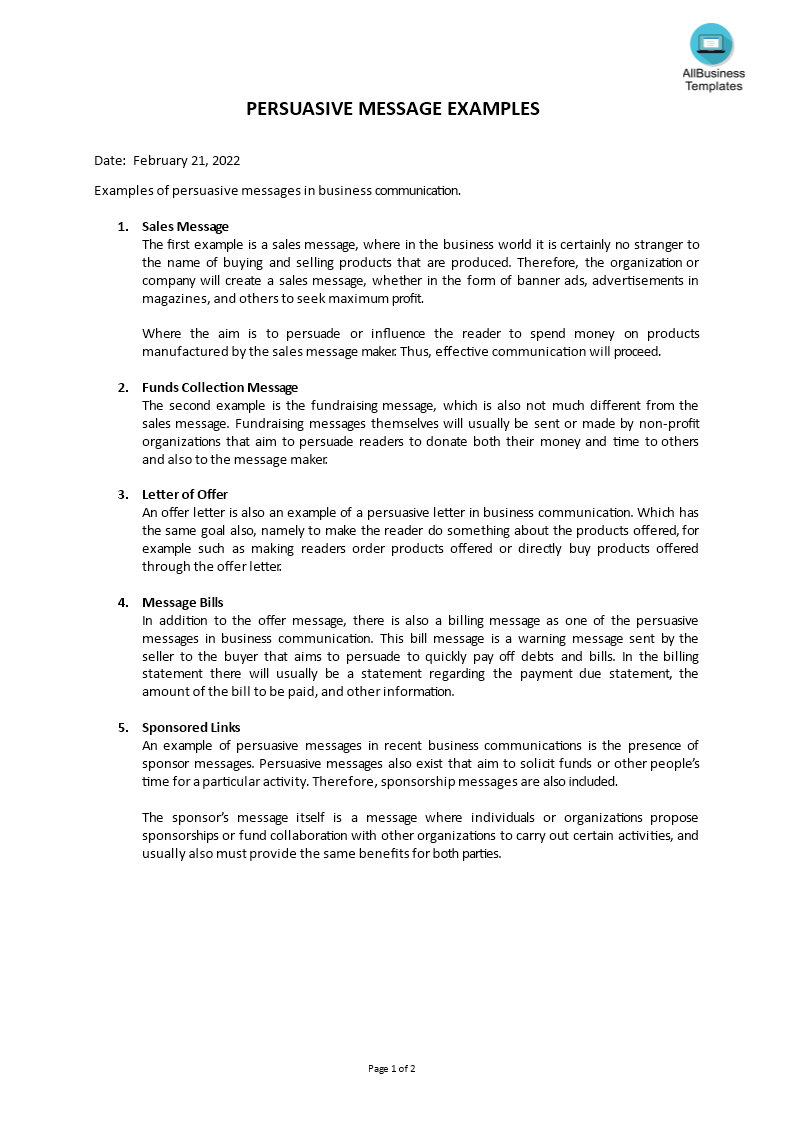Persuasive Communication Examples
Save, fill-In The Blanks, Print, Done!

Download Persuasive Communication Examples
Microsoft Word (.docx)Or select the format you want and we convert it for you for free:
- This Document Has Been Certified by a Professional
- 100% customizable
- This is a digital download (65.42 kB)
- Language: English
- We recommend downloading this file onto your computer.
How do you write a good persuasive message? What is persuasive messages give an example?
When you want to write a persuasive message, the key to be engaging and convert visitors to achieve your goals, is that the content attracts attention, intrigues, informs, convinces, or calls to action.
Persuasive messages can be successful, if they meet the demands of the reader, in terms of: reason vs emotion. Every piece of content has elements of:
- Ethos, or credibility;
- Pathos, or passion and enthusiasm; and
- Logos, or logic and reason.
In order to be persuasive, it's important to make a powerful mix of the above. By only focusing on reason with cold, hard facts and nothing but the facts, you may or may not appeal to your audience.
People make decisions on emotion as well as reason, and even if they have researched all the relevant facts, the decision may still come down to impulse, emotion, and desire.
On the other hand, if your persuasive message focuses solely on emotion, with little or no reasoning, it may not be taken seriously. Avoid using too many abstract terms, because not everybody is capable to understand these. If you wish to be persuasive in your writing, make sure your content contains all the elements, and don't expect your audience to fill in the blanks. The more concrete you are, the more it helps your readers to make sense of your message and the product or service.
Finally, if your persuasive message does not appear to have credibility that backs up the arguments, the message may be dismissed entirely.
Typical format of a persuasive message
- Attention statement (or hook): Use questions, humor, novelty, surprise, an unusual facts, top lists to get the attention of your audience.
- Introduction: Build interest by appealing to your audience’s needs and wants and include a purpose statement to set up expectations.
- Explanation: Establish credibility and build your relationship with your audience, discuss attractive features, and compare with competitors addressing concerns or potential questions before they are even considered.
- Call to action: Sum it up and offer solution steps or calls to action, motivating your audience to take the next step. The smaller the step, the more likely your audience will comply. Set up your audience for an effective closing. It should be clear what your audience should do, by when, and how.
Here you can see Examples of persuasive messages in business communication:
1. Sales Message: The first example is a sales message, where in the business world it is certainly no stranger to the name of buying and selling products that are produced. Therefore, the organization or company will create a sales message, whether in the form of banner ads, advertisements in magazines, and others to seek maximum profit.
Where the aim is to persuade or influence the reader to spend money on products manufactured by the sales message maker. Thus, effective communication will proceed.
2. Collection of Funds Message: The second example is the fundraising message, which is also not much different from the sales message. Fundraising messages themselves will usually be sent or made by non-profit organizations that aim to persuade readers to donate both their money and time to others and also to the message maker.
3. Sales or Offer Letter: A Sales letter or offer letter is also an example of a persuasive letter in business communication. Which has the same goal also, namely to make the reader do something about the products offered, for example such as making readers order products offered or directly buy products offered through the offer letter.
4. Bills Message: In addition to the offer message, there is also a billing message as one of the persuasive messages in business communication. This bill message is a warning message sent by the seller to the buyer that aims to persuade to quickly pay off debts and bills. In the billing statement there will usually be a statement regarding the payment due statement, the amount of the bill to be paid, and other information.
5. Sponsored Links: Persuasive messages to solicit funds or other people’s time for a particular activity. Therefore, sponsorship messages are also included. The sponsor’s message itself is a message where individuals or organizations propose sponsorships or fund collaboration with other organizations to carry out certain activities, and usually also must provide the same benefits for both parties.
As you can see, words formulated according to the right formula, appeals to emotion pique curiosity and get our attention, in addition it's important to add reason and facts as a part of the message. Also, it's not always important to write persuasive texts, for example when you are reading a technical product manual, there is no need to be persuasive and the reader expects solely to read basic information about design or features of the product.
Download these persuasive messages now for your reference.
DISCLAIMER
Nothing on this site shall be considered legal advice and no attorney-client relationship is established.
Leave a Reply. If you have any questions or remarks, feel free to post them below.
Related templates
Latest templates
Latest topics
- Excel Templates
Where do I find templates for Excel? How do I create a template in Excel? Check these editable and printable Excel Templates and download them directly! - GDPR Compliance Templates
What do you need to become GDPR compliant? Are you looking for useful GDPR document templates to make you compliant? All these compliance documents will be available to download instantly... - Google Docs Templates
How to create documents in Google Docs? We provide Google Docs compatible template and these are the reasons why it's useful to work with Google Docs... - IT Security Standards Kit
What are IT Security Standards? Check out our collection of this newly updated IT Security Kit Standard templates, including policies, controls, processes, checklists, procedures and other documents. - Letter Format
How to format a letter? Here is a brief overview of common letter formats and templates in USA and UK and get inspirited immediately!
cheese




